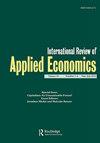遏制措施中的适应性学习:对2020年意大利新冠肺炎疫情期间政策干预措施的评估
IF 1.4
Q3 ECONOMICS
引用次数: 0
摘要
COVID-19大流行在两波中非常严重地袭击了意大利,第一波是在2020年春季,第二波是在同年秋冬之间。数据显示了这两个阶段之间的一些重大差异;特别是,第一波造成的感染较少,但死亡率较高。这些大流行的演变,加上社会条件的变化,要求迅速调整遏制措施,即在第一波中采取更严格和同质化的措施,在第二波中采取灵活和多样化的措施。对每日新病例数据进行的间断时间序列分析显示,两种干预措施在使感染曲线趋于平缓方面均取得了积极结果。这些政策在两次浪潮中避免了几乎相同比例的阳性病例。基于吸取以往结果的适应性和多样化政策似乎适合于不确定条件下的这种决策。©2023 Informa UK Limited以Taylor & Francis Group的名义进行交易。本文章由计算机程序翻译,如有差异,请以英文原文为准。
Adaptive learning in containment measures: evaluation of policy interventions during the 2020 waves of Covid-19 in Italy
The COVID-19 pandemic hit Italy very harshly in two waves, the first in spring 2020 and the second between the autumn and the winter of the same year. Data show some major differences between the two phases;in particular, the first wave caused fewer infections but had a higher fatality rate. These pandemic evolutions, together with modified social conditions, called for a rapid adaptation of containment measures, i.e. stricter and homogeneous in the first wave, flexible and diversified in the second wave. The interrupted time series analysis applied to daily data on new cases yields positive results for both interventions in flattening the infection curve. The policies achieved almost the same percentage of positive cases avoided in the two waves. Adaptive and diversified policies based on learning from previous results seem to be suitable for this kind of decision-making in conditions of uncertainty. © 2023 Informa UK Limited, trading as Taylor & Francis Group.
求助全文
通过发布文献求助,成功后即可免费获取论文全文。
去求助
来源期刊

International Review of Applied Economics
ECONOMICS-
CiteScore
4.30
自引率
4.50%
发文量
37
期刊介绍:
International Review of Applied Economics is devoted to the practical applications of economic ideas. Applied economics is widely interpreted to embrace empirical work and the application of economics to the evaluation and development of economic policies. The interaction between empirical work and economic policy is an important feature of the journal. The Journal is peer reviewed and international in scope. Articles that draw lessons from the experience of one country for the benefit of others, or that seek to make cross-country comparisons are particularly welcomed. Contributions which discuss policy issues from theoretical positions neglected in other journals are also encouraged.
 求助内容:
求助内容: 应助结果提醒方式:
应助结果提醒方式:


